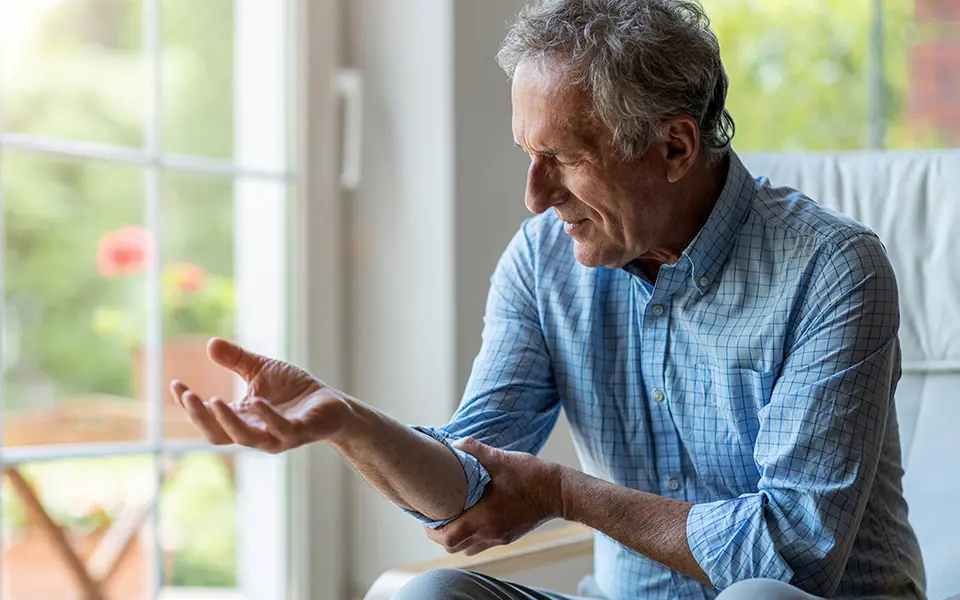November 22, 2021
What Is Osteoporosis & How Can It Be Prevented?
More than 53 million adults over 50 are diagnosed with osteoporosis, but most don’t know they have it until they break or fracture a bone. Learn about this silent disease and take preventative action to protect yourself.

What is Osteoporosis?
Weak or brittle bones characterize this disease. The tissue inside your bones is broken down and rebuilt constantly and is normally filled with tiny holes. But this condition compromises bone integrity by increasing the size of the holes and weakening the protective outer layer. Bone cell regeneration slows with age, but it becomes significantly impacted if you have osteoporosis.
Symptoms of Osteoporosis
It’s difficult to spot the symptoms in the early stages of this disease, but there are subtle warning signs that may indicate its progression, including:
- Loss of height over time
- Stooped posture
- Back pain
- Weak fingernails
- Reduced grip strength
- Receding gums
- Frequent bone fractures or breaks, especially in the hips and spine
- Slow healing process
Osteoporosis Risk Factors
Risk factors for osteoporosis can include:
- Age: Because bone density decreases with age, women over 65 and men over 70 are at an increased risk for osteoporosis.
- Gender: Women are more likely to develop this disease than men. Estrogen helps rebuild bone tissue, but menopause lowers a woman’s estrogen level, affecting bone health.
- Ethnicity: People of Caucasian, Latino and Asian descent are more likely to have osteoporosis.
- Family history: This condition is influenced by genetics, so you’re at an increased risk if you have a parent or sibling who has osteoporosis.
- Medication: Long-term steroid use affects the bone-rebuilding process.
- Alcohol and tobacco use: Drinking more than two alcoholic beverages a day increases your risk. Some of the chemicals in nicotine affect how your body uses and stores calcium, which harms your bone tissue.
Osteoporosis Prevention
Your bones are always rebuilding themselves, so it’s never too late to make lifestyle changes to protect yourself from osteoporosis.
Here are some tips to help prevent osteoporosis:
- Strengthen bones with calcium: Women need about 1,200 mg of calcium per day, and men need 1,000 mg daily. You’ll find good sources of calcium in low-fat dairy products, dark green leafy vegetables, soy products, orange juice and calcium-fortified cereals. You may also consider a calcium supplement to support bone health.
- Don’t forget Vitamin D: This vitamin helps your body absorb calcium, so it’s necessary to build strong bones. Your skin absorbs Vitamin D through sun exposure, but it’s usually not enough. Eat foods such as trout, salmon, eggs, chicken breast and beef liver.
- Limit or eliminate nicotine and alcohol: Your bones, and the rest of your body, will thank you if you cut back on drinking, smoking and chewing tobacco.
- Exercise: Weight-bearing activities such as jogging and walking revitalize your bones and improve their durability. Light weight training is also an option, but you should consult your physician before beginning a fitness regime.
- Schedule a bone density scan: This noninvasive process is like an X-ray or CT scan. It measures the amount of calcium and other minerals in a section of bone. Your results are assigned a T-score, and any number lower than -2.5 is indicative of osteoporosis.
- Reduce fall risks: Ensure your home is free of tripping hazards that could cause you to fall and fracture or break a bone.
Here are some easy ways to reduce your fall risk:
- Be mindful of cords, rugs and low furniture and clear them away from the high traffic areas of your house.
- Install rubber grips or matting to your shower or tub.
- Fix unstable handrails.
- Ensure each room has sufficient lighting.
- Wear low-heeled shoes that provide good traction.
Think Embassy!
Embassy Healthcare is committed to ensuring the physical well-being of each resident by providing well-rounded meals, medication management and exercise programs. Call 216-378-2050 or contact us online to schedule a tour.
